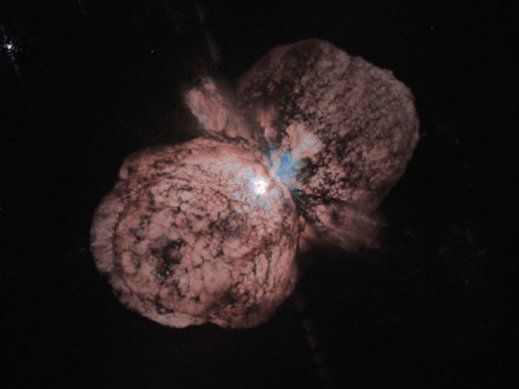Our Sun is about five billion years old, which is about halfway through its expected lifespan. A star begins as a collapsing cloud of gas, mostly hydrogen, and when the ball has grown dense enough under the pressure of its own gravitation, the hydrogen atoms begin to fuse into helium, liberating a tremendous amount of energy. This outward force acts as a counterbalance to the crushing inward pull of gravity, and the star settles into a comfortable equilibrium. Over time, fusion reactions occur between helium atoms as well, and begin working their way up through a series of elements, and the star takes on a layered structure, with the more massive elements toward the core. You might think that the more hydrogen a star starts off with — in other words, the more massive the star is — the longer it would last, but in fact it goes the other way, because the increased gravitional pressure due to the extra mass causes the fusion reactions to proceed more rapidly, more than making up for the extra “fuel”. The really big stars burn very brightly, very violently, and very briefly indeed compared to a modest specimen like ours: in contrast to the ten-billion-year lifespan of our Sun, giant stars may burn for less than a million years.
How a star dies depends on its mass. In the really big ones, there is enough fuel to drive the fusion sequence all the way up to iron, at which point the energy required to initiate further fusion is less than the energy the reaction itself would produce, and the process comes to a stop. At this point the star, which has been supported against the tremendous force of gravity by the fusion reactions in its core, catastrophically collapses, initiating the inconceivably energetic detonation known as a Type II supernova, in which the dying star’s energy output may equal, briefly, that of an entire galaxy.
Although they are enormously destructive events, if there were no supernovas we wouldn’t be around, either. The fusion reactions that take place inside massive stars, and during their cataclysmic deaths, are the only source of the heavy elements that rocky planets like Earth, and the living things that inhabit them, are made of. As Carl Sagan once put it: “We are made of starstuff.”
You don’t want to be too near one of these things when it goes off, though. As it happens, there is one in the southern sky that appears to be getting ready to blow: the “peculiar star” Eta Carinae, 9,000 or so light years away. It is a truly enormous star – at over 100 solar masses, one of the biggest anywhere – and it looks like this:
Eta Carinae appears to be in extremis, and may in fact already have exploded; the light from the event would take thousands of years to reach Earth, and may already be on its way. Don’t forget your sunscreen.

2 Comments
What SPF is recommended for that?
– M
I think 30 ought to do it, along with a lead apron.